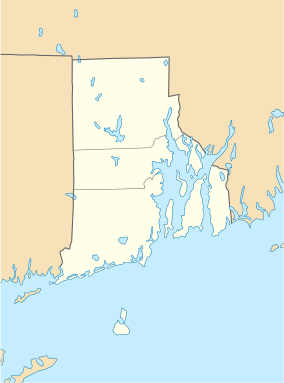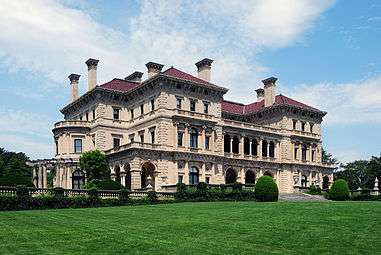Rosecliff
|
Rosecliff | |
.jpg) | |
  | |
| Location | 548 Bellevue Ave., Newport, Rhode Island |
|---|---|
| Coordinates | 41°27′55″N 71°18′20″W / 41.46528°N 71.30556°WCoordinates: 41°27′55″N 71°18′20″W / 41.46528°N 71.30556°W |
| Area | 6.5 acres (2.6 ha) |
| Built | 1898-1902 |
| Architect | Stanford White[1] McKim,Mead & White |
| Architectural style | French Baroque Revival |
| Part of | Bellevue Avenue Historic District (#72000023) |
| NRHP Reference # | 73000059[1] |
| Significant dates | |
| Added to NRHP | February 6, 1973 |
| Designated NHLDCP | December 8, 1972 |
Rosecliff, built 1898-1902, is one of the Gilded Age mansions[2] of Newport, Rhode Island, now open to the public as a historic house museum. The house has also been known as the Hermann Oelrichs House or the J. Edgar Monroe House.[1]
It was built by Theresa Fair Oelrichs, a silver heiress from Nevada, whose father James Graham Fair was one of the four partners in the Comstock Lode. She was the wife of Hermann Oelrichs, American agent for Norddeutscher Lloyd steamship line. She and her husband, together with her sister, Virginia Fair, bought the land in 1891 from the estate of George Bancroft, and commissioned the architectural firm of McKim, Mead, and White to design a summer home suitable for entertaining on a grand scale. With little opportunity to channel her considerable energy elsewhere, she "threw herself into the social scene with tremendous gusto, becoming, with Mrs. Stuyvesant Fish and Mrs. O.H.P. Belmont (of nearby Belcourt) one of the three great hostesses of Newport." [3]
The principal architect, Stanford White, modeled the mansion after the Grand Trianon of Versailles, but smaller and reduced to a basic "H" shape, while keeping Mansart's scheme of a glazed arcade of arched windows and paired Ionic pilasters, which increase to columns across the central loggia. White's Rosecliff adds to the Grand Trianon a second storey with a balustraded roofline that conceals the set-back third storey, containing twenty small servants' rooms and the pressing room for the laundry.
Construction and interiors
The commission was given to McKim, Mead, and White in 1898, and the New York branch of Jules Allard and Sons were engaged as interior decorators. Construction started in 1899, but the sharp winter slowed construction; Mrs. Oelrichs' sister had married William K. Vanderbilt II that winter season, and the house was required for parties in the following Newport season; the eager Mrs. Oelrichs moved in July 1900, sending the workmen out in order to give a first party in August, a dinner for one hundred and twelve to outdo Mrs. Stuyvesant Fish's Harvest Festival Ball at Crossways. Ferns and floral arrangements concealed the unfinished areas. The house was not completed until 1902.
Rosecliff's brick construction[4] is clad in white architectural terracotta tiles. Stanford White's sophisticated spatial planning[5] offered unexpected views en filade through aligned doorways centered on handsome monumental fireplaces with projecting overmantels.
The central corps de logis is entirely taken up with the ballroom as it appeared on White's plans which, with the Louis XIV furniture removed, could serve as Newport's largest ballroom at 40 by 80 feet. Its scheme of single and paired Corinthian pilasters alternating with arch-headed windows and recessed doorways echoes the articulation of the exterior. This is reached through the French doors on either side,[6] to a plain terrace dropping by broad stairs to the lawn facing the ocean, or to a planted terrace garden with a central fountain.
In the northernmost of the wings that project from both sides of the central block, is a dining room and a billiard room separated by a marble anteroom backed, on the service side, by a butler's pantry with two dumbwaiters. These communicate with the all-but-subterranean kitchens below which were lit, invisibly, from the sunken service yard on the north side of the house. The main entrance, on the opposite south wing, is through a vestibule where the exterior Ionic order is carried inside, now suitably enriched, under an emphatic cornice that divides the height 2:3.
The vestibule is separated, by a tripartite screen with an arched central opening flanked above the cornice by bull's-eye openings in which baroque vases stand, from a grand Stair Hall. The Stair Hall projects from the south block to accommodate a grand staircase that sweeps forward through a heart-shaped opening into the floor space. This divides at a landing to return in matched recurving flights to the upper floor.[7]
Beyond the Stair Hall is the Salon[8] with the same proportions as the Dining Room (3:4, or 30 by 40 feet) and like it, originally hung with tapestry. Its ceiling is coffered. Its overscaled Gothic fireplace of Caen stone is the one eclectic anomaly in Rosecliff's interiors.
Upstairs, three grand bedrooms of equal importance and guest bedrooms of graduated sizes may be linked by opened doors or isolated by locked ones, in a flexible arrangement of rooms or suites, all with baths, and all separated from the wide corridor by intervening dressing closets for hermetic privacy from the staff, who moved up and down stairs by means of two small service stairs contrived in spaces smaller than the master bedrooms' walk-in closets.
The most famous of Mrs. Oelrich's parties was the "Bal blanc" of 19 August 1904 to celebrate the Astor Cup Races, in which everything was white and silver.
The Monroe Family
Rosecliff stayed in the Oelrichs family until 1941, then went through several changes of ownership before being bought by Mr & Mrs J. Edgar Monroe of New Orleans in 1947. Mr. Monroe, a southern gentleman who had made his fortune in the ship building industry, came to Newport with his wife Louise every summer to escape the summer heat of the Deep South. The two became well known for the large parties they threw at Rosecliff; many of which had mardi gras theme, the Monroes loved dressing up in fancy costumes for these parties. Unlike Mrs. Oelrichs' parties, which were stiff and formal, the Monroes' parties were laid back and easy going. In fact, the Monroe's are responsible for the creation of the rose, used as the namesake for Rosecliff. Because Hermann Oelrichs Jr had sold off all the furnishings in 1941, nearly all the furnishings visitors see at Rosecliff today are from the Monroe period of occupation. In 1971, Mr. and Mrs. Monroe donated the entire estate with its contents and a $2 million operating endowment to the Preservation Society of Newport County, who opened it to the public for tours. Mr Monroe often would come back to the estate for charity events up until his death in 1991.
The ballroom was used to film scenes for the 1974 version of The Great Gatsby, The Betsy, High Society,[9] True Lies, and Amistad.
See also
- Baroque Revival architecture
- List of Gilded Age mansions
- National Register of Historic Places listings in Newport County, Rhode Island
References
- 1 2 3 National Park Service (2009-03-13). "National Register Information System". National Register of Historic Places. National Park Service.
- ↑ Newport summer houses were always referred to as "cottages", no matter how grand they were.
- ↑ Ferguson 1977, p. 7)
- ↑ White had no reservations about employing steel girders to span the vast ballroom, in order to support three guest bedrooms with two baths, with their closets, dressing rooms and other appurtenances directly above.
- ↑ Floor plans are in J. Walton Ferguson, Rosecliff 1977
- ↑ The cross ventilation kept the room from becoming stifling when it was filled at large parties in August's heat.
- ↑ "Its overall shape and splendid flow of mass and space probably owes something to the example of Richard Morris Hunt's staircase in The Breakers and, ultimately, to the great staircase that the German architect Balthasar Neumann designed for the prince-archbishop's palace at Brühl in 1741". (Ferguson 1977, p. 17.
- ↑ Contemporary newspaper articles avoid "salon", with its uneasy American connotations, and term this room the "drawing room" or "reception room."
- ↑ Internet Movie Database: High Society (1956): Locations.
- J. Walton Ferguson, Rosecliff, Newport: Preservation Society of Newport County, 1977.
External links
| Wikimedia Commons has media related to Rosecliff. |
